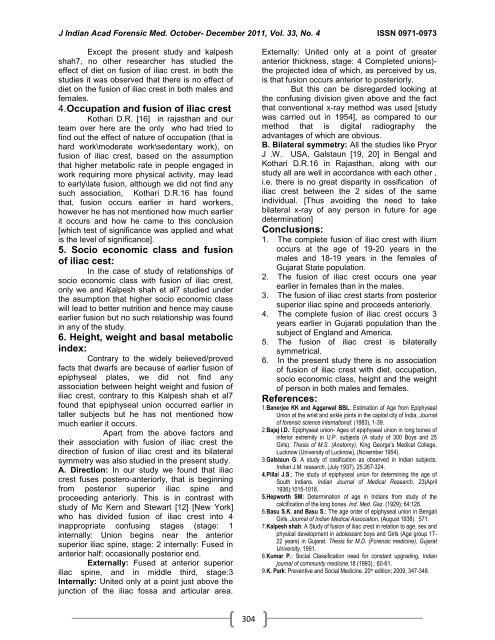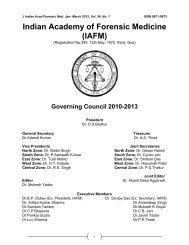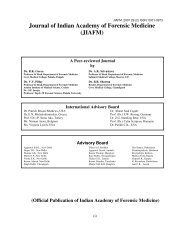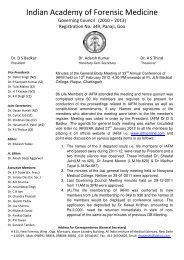Indian Academy of Forensic Medicine (IAFM) - Official website of IAFM
Indian Academy of Forensic Medicine (IAFM) - Official website of IAFM
Indian Academy of Forensic Medicine (IAFM) - Official website of IAFM
Create successful ePaper yourself
Turn your PDF publications into a flip-book with our unique Google optimized e-Paper software.
J <strong>Indian</strong> Acad <strong>Forensic</strong> Med. October- December 2011, Vol. 33, No. 4 ISSN 0971-0973<br />
Except the present study and kalpesh<br />
shah7, no other researcher has studied the<br />
effect <strong>of</strong> diet on fusion <strong>of</strong> iliac crest. in both the<br />
studies it was observed that there is no effect <strong>of</strong><br />
diet on the fusion <strong>of</strong> iliac crest in both males and<br />
females.<br />
4. Occupation and fusion <strong>of</strong> iliac crest<br />
Kothari D.R. [16] in rajasthan and our<br />
team over here are the only who had tried to<br />
find out the effect <strong>of</strong> nature <strong>of</strong> occupation (that is<br />
hard work\moderate work\sedentary work), on<br />
fusion <strong>of</strong> iliac crest, based on the assumption<br />
that higher metabolic rate in people engaged in<br />
work requiring more physical activity, may lead<br />
to early\late fusion, although we did not find any<br />
such association, Kothari D.R.16 has found<br />
that, fusion occurs earlier in hard workers,<br />
however he has not mentioned how much earlier<br />
it occurs and how he came to this conclusion<br />
[which test <strong>of</strong> significance was applied and what<br />
is the level <strong>of</strong> significance].<br />
5. Socio economic class and fusion<br />
<strong>of</strong> iliac cest:<br />
In the case <strong>of</strong> study <strong>of</strong> relationships <strong>of</strong><br />
socio economic class with fusion <strong>of</strong> iliac crest,<br />
only we and Kalpesh shah et al7 studied under<br />
the asumption that higher socio economic class<br />
will lead to better nutrition and hence may cause<br />
earlier fusion but no such relationship was found<br />
in any <strong>of</strong> the study.<br />
6. Height, weight and basal metabolic<br />
index:<br />
Contrary to the widely believed/proved<br />
facts that dwarfs are because <strong>of</strong> earlier fusion <strong>of</strong><br />
epiphyseal plates, we did not find any<br />
association between height weight and fusion <strong>of</strong><br />
iliac crest, contrary to this Kalpesh shah et al7<br />
found that epiphyseal union occurred earlier in<br />
taller subjects but he has not mentioned how<br />
much earlier it occurs.<br />
Apart from the above factors and<br />
their association with fusion <strong>of</strong> iliac crest the<br />
direction <strong>of</strong> fusion <strong>of</strong> iliac crest and its bilateral<br />
symmetry was also studied in the present study.<br />
A. Direction: In our study we found that iliac<br />
crest fuses postero-anteriorly, that is beginning<br />
from posterior superior iliac spine and<br />
proceeding anteriorly. This is in contrast with<br />
study <strong>of</strong> Mc Kern and Stewart [12] [New York]<br />
who has divided fusion <strong>of</strong> iliac crest into 4<br />
inappropriate confusing stages (stage: 1<br />
internally: Union begins near the anterior<br />
superior iliac spine, stage: 2 internally: Fused in<br />
anterior half; occasionally posterior end.<br />
Externally: Fused at anterior superior<br />
iliac spine, and in middle third, stage:3<br />
Internally: United only at a point just above the<br />
junction <strong>of</strong> the iliac fossa and articular area.<br />
304<br />
Externally: United only at a point <strong>of</strong> greater<br />
anterior thickness, stage: 4 Completed unions)the<br />
projected idea <strong>of</strong> which, as perceived by us,<br />
is that fusion occurs anterior to posteriorly.<br />
But this can be disregarded looking at<br />
the confusing division given above and the fact<br />
that conventional x-ray method was used [study<br />
was carried out in 1954], as compared to our<br />
method that is digital radiography the<br />
advantages <strong>of</strong> which are obvious.<br />
B. Bilateral symmetry: All the studies like Pryor<br />
J .W. USA, Galstaun [19, 20] in Bengal and<br />
Kothari D.R.16 in Rajasthan, along with our<br />
study all are well in accordance with each other ,<br />
i.e. there is no great disparity in ossification <strong>of</strong><br />
iliac crest between the 2 sides <strong>of</strong> the same<br />
individual. [Thus avoiding the need to take<br />
bilateral x-ray <strong>of</strong> any person in future for age<br />
determination]<br />
Conclusions:<br />
1. The complete fusion <strong>of</strong> iliac crest with ilium<br />
occurs at the age <strong>of</strong> 19-20 years in the<br />
males and 18-19 years in the females <strong>of</strong><br />
Gujarat State population.<br />
2. The fusion <strong>of</strong> iliac crest occurs one year<br />
earlier in females than in the males.<br />
3. The fusion <strong>of</strong> iliac crest starts from posterior<br />
superior iliac spine and proceeds anteriorly.<br />
4. The complete fusion <strong>of</strong> iliac crest occurs 3<br />
years earlier in Gujarati population than the<br />
subject <strong>of</strong> England and America.<br />
5. The fusion <strong>of</strong> iliac crest is bilaterally<br />
symmetrical.<br />
6. In the present study there is no association<br />
<strong>of</strong> fusion <strong>of</strong> iliac crest with diet, occupation,<br />
socio economic class, height and the weight<br />
<strong>of</strong> person in both males and females.<br />
References:<br />
1. Banerjee KK and Aggarwal BBL: Estimation <strong>of</strong> Age from Epiphyseal<br />
Union at the wrist and ankle joints in the capital city <strong>of</strong> India, Journal<br />
<strong>of</strong> forensic science international: (1983), 1-39.<br />
2. Bajaj I.D.: Epiphyseal union- Ages <strong>of</strong> epiphyseal union in long bones <strong>of</strong><br />
inferior extremity in U.P. subjects (A study <strong>of</strong> 300 Boys and 25<br />
Girls). Thesis <strong>of</strong> M.S. (Anatomy), King George’s Medical College,<br />
Lucknow (University <strong>of</strong> Lucknow), (November 1954).<br />
3. Galstaun G: A study <strong>of</strong> ossification as observed in <strong>Indian</strong> subjects.<br />
<strong>Indian</strong> J.M. research, (July 1937), 25:267-324.<br />
4. Pillai J.S.: The study <strong>of</strong> epiphyseal union for determining the age <strong>of</strong><br />
South <strong>Indian</strong>s. <strong>Indian</strong> Journal <strong>of</strong> Medical Research, 23(April<br />
1936):1015-1018.<br />
5. Hepworth SM: Determination <strong>of</strong> age in <strong>Indian</strong>s from study <strong>of</strong> the<br />
calcification <strong>of</strong> the long bones. Ind. Med. Gaz. (1929); 64:128.<br />
6. Basu S.K. and Basu S.: The age order <strong>of</strong> epiphyseal union in Bengali<br />
Girls. Journal <strong>of</strong> <strong>Indian</strong> Medical Association, (August 1938). 571.<br />
7. Kalpesh shah: A Study <strong>of</strong> fusion <strong>of</strong> iliac crest in relation to age, sex and<br />
physical development in adolescent boys and Girls (Age group 17-<br />
22 years) in Gujarat. Thesis for M.D. (<strong>Forensic</strong> medicine), Gujarat<br />
University, 1991.<br />
8. Kumar P.: Social Classification need for constant upgrading, <strong>Indian</strong><br />
journal <strong>of</strong> community medicine,18 (1993).: 60-61.<br />
9. K. Park: Preventive and Social <strong>Medicine</strong>. 20 th edition; 2009, 347-348.









